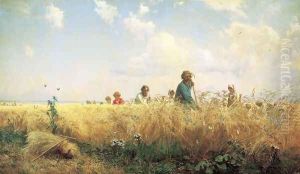Grigoriy Grigoryevich Myasoyedov Paintings
Grigoriy Grigoryevich Myasoyedov was a prominent Russian painter, a member of the Peredvizhniki (Wanderers), and an influential figure in the Russian realist movement of the late 19th century. Born on April 19, 1834, in the village of Novaya Sloboda in the Tula Governorate of the Russian Empire, Myasoyedov grew up in an environment that was to profoundly influence his future artistic work. He was exposed to the lives of the peasantry and the natural landscape, which would later become central themes in his paintings.
Myasoyedov's early education was in the city of Tula, where he demonstrated an early interest in art. In 1853, he moved to Saint Petersburg to study at the Imperial Academy of Arts. During his time at the Academy, he was exposed to the works of acclaimed artists and received a traditional academic art education. Myasoyedov graduated with a gold medal in 1861, which afforded him the opportunity to travel abroad to further his studies.
He spent several years in Europe, particularly in Italy and France, where he was influenced by the works of the Old Masters and contemporary Western European art movements. Upon his return to Russia, Myasoyedov became an active participant in the burgeoning realist movement, which sought to portray the lives of ordinary people and social issues with sincerity and compassion.
In 1870, Myasoyedov was one of the founding members of the Society for Travelling Art Exhibitions, commonly known as the Peredvizhniki or Wanderers. This group of artists broke away from the official academic art circles to bring art directly to the people, organizing traveling exhibitions throughout the Russian Empire. Myasoyedov's work with the Wanderers solidified his reputation as a leading realist painter.
His most famous works often depicted the rural life of Russian peasants, reflecting both his critical perspective on social injustice and his profound empathy for the working class. Pieces such as 'The Zemstvo Dines' (1872) highlighted the contrast between the lives of the peasantry and the local government officials, while 'Praying for the Crops' (1887) showed the deep connection between the peasants and their land.
Myasoyedov's commitment to realism was not limited to his artistic practice; he was also a vocal advocate for social reform. His art was a powerful tool in raising awareness about the hardships faced by the lower classes and the need for societal change.
Towards the end of his life, Myasoyedov's influence waned as newer art movements began to emerge. However, his contributions to Russian art were significant, and he remained an active painter and participant in the arts community until his death on October 16, 1911, in the village of Polenovo, Tula Governorate. Today, Myasoyedov's works are held in high regard and can be found in major Russian museums, including the Tretyakov Gallery in Moscow, reflecting his enduring legacy as a key figure in Russian realist art.
